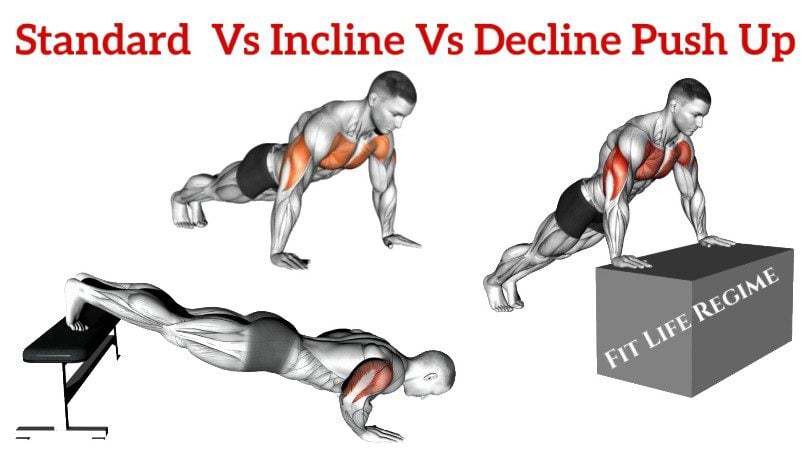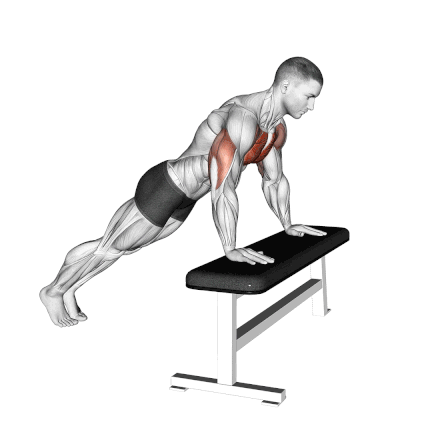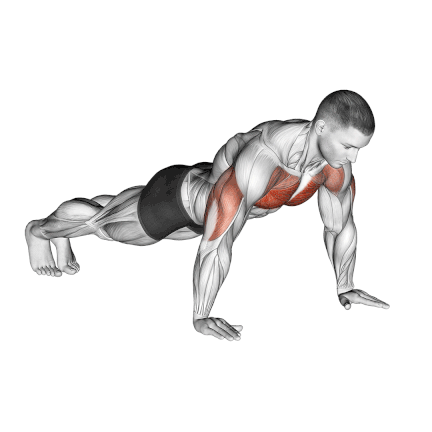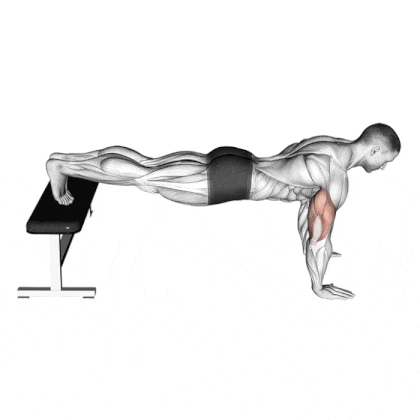Ever wondered why Navy SEALs, elite athletes, and physical therapists all swear by push-ups? It’s not just because they’re free and convenient (though that helps).
Here’s what makes push-ups fascinating: Studies show they activate 20+ different muscles simultaneously, making them more efficient than many fancy gym machines.
Just like a Swiss Army knife, push-ups come with different blades for different tasks (Muscles Activation & Intensity).
Today we’re diving into the three push-up variations that give you the most bang for your buck:
- Standard push-ups (the classic everyone knows)
- Incline push-ups (to focus more on the lower chest)
- Decline push-ups (to focus more on the upper chest)
Think of these as your push-up progression ladder. Each variation targets different muscle groups and provides unique benefits that I have tested and verified through research.
Let me explain how each works and which is best for you.

- Incline Vs Standard Vs Decline Push Up Muscles Worked
- Muscles Worked
- Which Push-Up Is Easier and More Difficult?
- Standard Push Up Vs Incline Push Up Vs Decline Push Up
- Incline Push-Up
- Standard Push-Ups
- Decline Push-Up
- FAQs
- Which Type Of Push-Up Should You Do?
- Do Decline Push Ups Work Upper Chest
- What Do Incline Push-Ups Work
- Are Incline Push-Ups Easier Than Decline?
- Decline Push-Up Vs Regular Push-Up
- Incline Push-Ups Vs Decline Push-Ups
- References
Incline Vs Standard Vs Decline Push Up Muscles Worked
Muscle activation of push-ups is typically examined through hand and body placement variations, such as normal push-ups, incline, and decline push-ups.
You can use these types of push-ups to change your fitness program and offer a range of low- to high-intensity options.
Standard Push-ups are a compound strength-training exercise that involves raising and lowering the body using the arms while facing down in a prone, horizontal position.
Muscles Worked
- Primary Muscles Worked: Pectoralis Major, Anterior deltoids (shoulder muscle), and triceps.
- Secondary Muscles Worked: lateral deltoid, serratus, trapezius, and core muscles (abs, lumbar, gluteal, pelvic, and deep spinal muscles).
- Stabilizing Muscles: Serratus Anterior, Rhomboids and Trapezius, Erector Spinae
All three variations of the push-up — normal, incline, and decline—use your chest, triceps, shoulders, and core muscles. However, because of the angle, the Incline push-up works your lower chest and core more.
On the other hand, the decline push-up works the upper chest and front shoulders (delts) more than the regular or incline variation.
If you’re looking to work your shoulders, you could try doing pike push-ups.
Want to take your gains to the next level? Discover your daily calorie needs with our free TDEE calculator
Which Push-Up Is Easier and More Difficult?
Changing your push-up’s angle can make it either 50% easier or significantly harder.
Easiest → Hardest (In Order):
- Incline Push-Ups (Beginner-Friendly)
- Standard Push-Ups (The Baseline)
- Decline Push-Ups (Advanced)
If a standard push-up is too hard for you, inline push-ups are the perfect solution. Push-ups are easier if you are upright. They will be ~50% easier if you have a 45-degree angle with your feet below your head than if you have a horizontal angle.
Incline push-ups are easier than normal push-ups because of the angle at which the exercise has to be done. The incline surface means that more of the lower chest, shoulder muscles, and triceps are used in incline push-ups.
Decline push-ups are harder than standard push-ups because of the angle at which they have to be done. The decline position means that more of the upper chest, shoulder muscles, and triceps are used.
Standard Push Up Vs Incline Push Up Vs Decline Push Up
With a regular (normal) push-up, you are lifting about 64% of your own bodyweight.
Incline Push-Up
The incline push-up is a great bodyweight exercise for building chest strength. It offers numerous benefits and is perfectly suited for both beginners and experienced athletes.
Incline push-ups are easier than normal push-ups because of the angle at which they have to be done. The elevated hand position requires less body weight to lift.
You can also use objects like a chair, a gym bench, a sofa, a box, a sturdy table, or anything else.
Your Personal Push-Up Platform Options:
- Wall (Beginner level – 20% body weight)
- Kitchen counter (Intermediate – 40% body weight)
- Sturdy bench (Advanced – 60% body weight)
- Low box (Pre-standard push-up – 80% body weight)
How To Do

- Stand approximately 3 to 3.5 feet away from a low bench or sturdy chair. Ensure the box or bench is sturdy and won’t slide.
- Place your hands on the box shoulder-width apart, with your fingers pointing forward.
- Your palms should be flat, with fingers pointing forward or slightly turned inwards. Keep a neutral back position with your chest up and head facing forward.
- Slowly lower yourself by flexing your elbows so that your chest comes within a few inches of the edge of the chair or bench.
- Keep your elbows at about a 45-degree angle to your torso. Your chest should be directed towards the box and not your face.
- Push yourself back to the starting position while keeping your body straight from head to ankle.
- Do 3-4 sets of 10-15 reps.
Standard Push-Ups
While incline and decline push-ups have their place, the standard push-up is your bread and butter.
The classic push-up has survived the test of time and is the single most efficient exercise to simultaneously strengthen the chest, arms, deltoid, lower back, abs and glutes.
Standard push-ups are one of the most basic but rewarding all-around exercises you will find, and everyone from teenagers to older adults can benefit from doing them regularly.

How To Do
- Plant your palms firmly on the ground (shoulder-width apart). Extend your legs back fully.
- Create one straight line from your heels to your head (this is crucial) Pro tip: Think steel rod from head to toe.
- Keep your core tight (like you’re about to get punched).
- Push yourself up with controlled force, bottom line? Your entire body should move as one unit.
- Hold for a 1-second isometric pause (This maximizes “time under tension”)
- Lower yourself with military precision.
- Stop when your chest is 2 inches from the ground Key point:
Decline Push-Up
The Decline Push-up is a great exercise to start with if you want to train your upper chest with push ups at home.
It is similar to normal push-ups, but with your legs on a bench. Although this is called the decline push-up, it focuses more on the upper pecs.
Furthermore, your lower body is raised from the floor, and your body’s resistance is increased compared to doing the push-up on the floor. This makes the decline push-up harder than the standard push-up.

How To Do
- Find a sturdy bench or pad roller at hip height. Placed your hands firmly on the floor and spaced slightly wider than shoulder-width apart. Put legs on the bench or the pad roller.
- Keep elbows at a 45-degree angle to your body (not flared out)
- Lower your chest toward the ground with complete control.
- Stop when your chest is 2-3 inches from the floor.
- Drive through your palms like you’re pushing the earth away
- Keep your core braced (imagine preparing for a punch to the stomach)
- Press until your arms are 98% straight (avoid full lockout to maintain tension)
FAQs
Which Type Of Push-Up Should You Do?
For a more well-rounded physique, you might consider using various push-ups.
- Standard push-ups are best for the chest, shoulder, and tricep.
- Incline Push Up works on your lower chest and back more.
- On the other hand, the decline push-up works the upper chest and front shoulders more than the regular or incline variation.
- Close grip push-ups focus more on the tricep than the chest.
- Pike Push-ups focus more on shoulder than chest and tricep.
Do Decline Push Ups Work Upper Chest
The decline push-up is one of the best pushups for the upper chest. You will be expected to decline at a certain angle to complete this move. The ‘declination’ helps target the upper chest muscles.
What Do Incline Push-Ups Work
The incline position primarily works your lower chest muscles, but you’ll also need to engage your upper chest, shoulder, tricep and core muscles.
Are Incline Push-Ups Easier Than Decline?
Incline pushups are easier than regular or decline pushups. The incline position reduces the amount of bodyweight you are lifting and puts less stress on your elbows.
The Inline push-up is a great way to build your chest, shoulder, and tricep, and it is perfect for both beginners and pros.
Decline Push-Up Vs Regular Push-Up
When you do decline push-ups, you lift more of your body weight, which makes the decline push-up variation harder than the regular push-up variation.
A decline variation targets your upper chest and fronts of shoulders more aggressively than a regular push-up performed on level ground.
Incline Push-Ups Vs Decline Push-Ups
Incline pushups are easier than basic pushups, while decline pushups are harder. The downward angle of a decline push-up forces you to lift more of your body weight.
Both variations work your chest, triceps, shoulders, and back muscles. However, because of the angle, the Incline push-up works your lower chest and back more.
On the other hand, the decline push-up works the upper chest and front shoulders more than the regular or incline variation.
Once you’ve mastered the incline and basic pushups, try the decline pushup. It is an excellent exercise for challenging your upper chest and shoulders.
References
- Ebben WP, Wurm B, Vanderzanden TL, et al. Kinetic analysis of several variations of push-ups. J Strength Cond Res 2011; 25: 2891–2894.
- Hollman JH, Stout JR. Comparison of Muscle-Activation Patterns During the Conventional Push-Up and Perfect· Pushup™ Exercises. The Journal of Strength and Conditioning Research. 2010 Dec;24(12):3352-62.
- Cogley RM, Archambault TA, Fibeger JF, Koverman MM. Comparison of muscle activation using various hand positions during the push-up exercise. Journal of strength and conditioning research. 2005 Aug 1;19(3):628.

Manish is a NASM-certified fitness and nutrition coach with over 10 years of experience in weight lifting and fat loss fitness coaching. He specializes in gym-based training and has a lot of knowledge about exercise, lifting technique, biomechanics, and more.
Through “Fit Life Regime,” he generously shares the insights he’s gained over a decade in the field. His goal is to equip others with the knowledge to start their own fitness journey.
